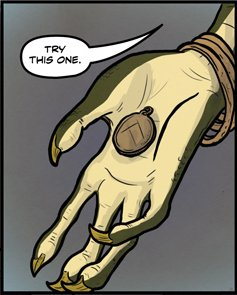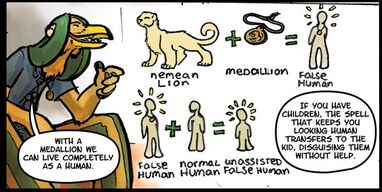
Madam U holding an older Nokk medallion.
A medallion is a small magical token that is worn by most sentient mythical creatures in order to appear human. This is accomplished through a "solid illusion" that is generated by the medallion, allowing a creature to not only appear human, but physically become a human. Medallions are immensely varied in their composition and appearance, and have been seen to be made from stone, seashells, bone, and various types of metal. Medallions are also made specifically for every individual species, and will remain inert until exposed to their corresponding species.
The first medallions produced where simple in design, typically a coin-shaped piece of featureless bronze or a similar metal. All "newer" medallions have some way of displaying which species they are intended for use by, either from a detailed carving in the front face of the medallion or, in the case of some medallions, through the use of simple symbolism to hint at their target species. Examples of symbolic medallions include nixie medallions, which are often in the form of a simple seashell, and bugbear medallions, which are in the form of black widow spiders.
A medallion can only be used by one individual at a time, and that person cannot switch medallions once they have received theirs. Medallions currently in use by a living individual can be willingly relinquished to an unturned creature of the same species, but once this happens, the same restrictions regarding the use of other medallions still applies, and the now medallion-less creature is essentially trapped in the body of their species, with no way of ever using a medallion to appear human for the rest of their lives.
Spell Inheritance[]

Jim explains the concept of human form inheritance.
Any medallion-using creature who assumes a human form is capable of producing viable offspring with an actual human. When this child is born to a human mother, or if the mother is a nonhuman in human form, they will be born as the species of one of their nonhuman parents with the same illusion produced by a medallion, minus the need for a medallion to stay human. The child can then have children who are also disguised as humans, and this can continue indefinitely, with every viable descendant being a nonhuman in human form. No matter how little nonhuman blood remains in the family bloodline, they will still be mythical beings under the spell, and as such are capable of utilizing medallions. One exception to this rule applies if a family with a creature of a gender specific species, such as satyrs, has a child that the species cannot exist in. If the child of a satyr were female, they would be truly human, but if that female eventually had a son, the son would be a satyr.
People who were born with an inherited solid illusion disguising them are often unaware of their nature as mythical beings and live their entire lives as humans. These individuals are referred to as unturned, and compose up to a possible 0.1% of the world population. The reason there are so few mythical beings seen is not due to endangerment of any species, but rather that most of each species are unknowingly disguised as a human. If any one of these unturned humans somehow obtained a medallion of their own, the previously inherited and unassisted illusion would be replaced by a illusion dependent on their medallion, causing them to turn and reveal their natural form.
Origin[]
The method used for the creation of medallion was lost around (or possibly even before) the Great War between the sphinxes and the dragons. This means that any medallion still existing as of the 21st century are at least an astonishing 800 years old.
Due to the length of time since medallions were last produced, there is a finite amount of them existing in the world. There is not, however, anything close to a shortage, and if a species ever had a medallion produced for them to begin with, there is a very good chance that they would still be able to find a usable medallion in the modern age. However, some species never had medallions made for their species, usually ones regarded in mythology as exceptionally dangerous or violent, or who are naturally capable or appearing human through the use of magic or shape shifting. Species with no medallions and no other means of appearing human are referred to as monsters. Some examples of what are considered monsters include harpies, manticores, gorgons, lamias, bandersnatches, and strangely, cheshire cats.
Older medallions, characterized by their smooth, featureless faces, contain raw, less streamlined magic. While this has little effect when used by the proper species, the magic is strong enough to even have effects on the unturned of other species, forcing a turning without bonding to the person being turned, even if the unturned appeared human through non-medallion means. One example of a person being turned by an older medallion is Allelean harpy Anthony Gillis, who is a member of a species that does not even have a medallion.
Usage[]
Medallions contain magic of extreme intricacy, allowing a variety of transformation related actions. However, their intricacy is the primary reason that medallions can no longer be produced. Children, unturned or otherwise, are typically required to wait until around the age of ten (or an equivalent age for their species) before they are given a medallion due to the mental faculties required to maintain a stable human or nonhuman form.
In the event that an individual shifts to full form while wearing an article of clothing that might be damaged in the process, that article of clothing is magically "stored" until properly usable again. Clothing that is still properly wearable or required to prevent any culture's concept of nudity from occurring is typically retained. An example of this is most easily seen in female sphinxes, who typically have any pants or skirts stored to accommodate a lion lower body, but retain shirts and other upper body accessories to cover the human upper body. This process of storage is not perfect however, and in some cases where a necessary article of clothing cannot accommodate extra or altered appendages, it is common for tearing to occur in order to allow space for structures such as wings. Medallions cannot store themselves, and are not affected by the storage mechanism at all, with the possible exception of being able to adjust the necklace they are placed on to better suit a person's change in size.
After a medallion user becomes familiar with both their human form and their natural body, or full form, they may choose to adopt a body combining the most appealing traits of both. These are known as "midforms", and typically consist of a humanoid skeletal structure with the aesthetic traits (eyes, hooves, paw pads, teeth, nose structure, feathers, and fur) of their natural form. Other physical traits, such as claws, tails, and wings, remain fully functional if included in a mid form, and the heightened senses available in full form are also retained. Midforms are not locked in any species-specific shape, and some individuals, such as David Haywood, often change appearances at a very rapid pace.
Midforms that use the corresponding bones of both human and full form at the same time usually end with the most streamlined result, even if a mid form ends up having more bones than is found in either species. This is typically only seen in the smaller details of a midform. One example is seen in many lion-like species, whose mid forms include human fingers tipped with retractable claws. Even though the last bone in each human finger (the distal phalange) corresponds to the bones on which a retractable claw is attached to, midforms retain both a fully functional hand and fully functional claws. This is most likely due to the medallion generating an extra bone on each finger and the thumb, even if such a bone structure exists in neither the human or full form of an individual. This type of phenomena does not extend to most other species' midform, as species like ouzelum birds cannot have both human arms and wings at the same time. Also, midforms typically must include the general features of either a human or their actual species. Gryphons can hide their wings to wear human clothing, but they cannot produce wing feathers in any place they would not normally be.
A medallion must be within a few inches of its owner to work, and because of this most medallions are worn at all times on necklaces that are adjustable in size, to prevent the loss of a medallion when an individual changes appearance or loses clothes in the storage process, as well as to always have the medallion in an owner's proximity. If a medallion moves too far away from its owner at any time, the owner is immediately forced into a full form. Because of the consequences resulting from losing or breaking a medallion, it is likely that touching or attempting to remove another person's medallion is generally considered taboo.
Damage[]
If a medallion is significantly fractured or otherwise damaged, it results in immediate, permanent, and random failures in the spell that allows an illusion of humanity. Because medallions are bound to a person for life, the results of damage to a medallion are effectively permanent. Myra Reinkemeyer and Greg Tragos have damaged medallions and have to hide their bugbear eye and satyr ears, respectively. It is likely that most medallion are magically reinforced to protect against more damage, as it is very unlikely that a similar item of the same materials would survive intact for such a long period of time.